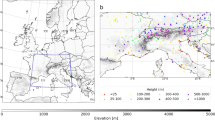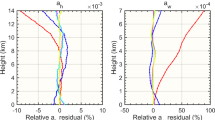Abstract
Prior numerical modelling studies show that atmospheric dispersion is sensitive to surface heterogeneities, but past studies do not consider the impact of a realistic distribution of surface heterogeneities on mesoscale atmospheric dispersion. While these focussed on dispersion in the convective boundary layer, the present work also considers dispersion in the nocturnal boundary layer and above. Using a Lagrangian particle dispersion model (LPDM) coupled to the Eulerian Regional Atmospheric Modeling System (RAMS), the impact of topographic, vegetation, and soil moisture heterogeneities on daytime and nighttime atmospheric dispersion is examined. In addition, the sensitivity to the use of Moderate Resolution Imaging Spectroradiometer (MODIS)-derived spatial distributions of vegetation characteristics on atmospheric dispersion is also studied. The impact of vegetation and terrain heterogeneities on atmospheric dispersion is strongly modulated by soil moisture, with the nature of dispersion switching from non-Gaussian to near-Gaussian behaviour for wetter soils (fraction of saturation soil moisture content exceeding 40%). For drier soil moisture conditions, vegetation heterogeneity produces differential heating and the formation of mesoscale circulation patterns that are primarily responsible for non-Gaussian dispersion patterns. Nighttime dispersion is very sensitive to topographic, vegetation, soil moisture, and soil type heterogeneity and is distinctly non-Gaussian for heterogeneous land-surface conditions. Sensitivity studies show that soil type and vegetation heterogeneities have the most dramatic impact on atmospheric dispersion. To provide more skilful dispersion calculations, we recommend the utilisation of satellite-derived vegetation characteristics coupled with data assimilation techniques that constrain soil-vegetation-atmosphere transfer (SVAT) models to generate realistic spatial distributions of surface energy fluxes.
Similar content being viewed by others
References
Alapaty K, Niyogi D, Chen F et al (2008) Development of the flux-adjusting surface data assimilation system for mesoscale models. J Appl Meteorol Climatol 47: 2331–2350
Carlson TN, Ripley DA (1997) On the relation between NDVI, fractional vegetation cover, and leaf area index. Remote Sens Environ 62: 241–252
Chen C, Cotton WR (1983) A one-dimensional simulation of the stratocumulus-capped mixed layer. Boundary-Layer Meteorol 25: 289–321
Cotton WR, Pielke RA, Walko RL et al (2002) RAMS 2001: current status and future directions. Meteorol Atmos Phys 82: 5–29
De Lannoy GJM, Houser PR, Pauwels VRN, Verhoest NEC (2007) State and bias estimation for soil moisture profiles by an ensemble Kalman filter: Effect of assimilation depth and frequency. Water Resour Res 43: W06401. doi:10.1029/2006WR005100
Eastman JL, Pielke RA, Lyons WA (1995) Comparison of lake-breeze model simulations with tracer data. J Appl Meteorol 34: 1398–1418
Eastman JL, Pielke RA, McDonald DJ (1998) Calibration of soil moisture for large eddy simulations over the FIFE area. J Atmos Sci 55: 1131–1140
Gifford FA (1982) Horizontal diffusion in the atmosphere: a Lagrangian-dynamical theory. Atmos Environ 16: 505–512
Gopalakrishnan S, Avissar R (2000) LES study of the impacts of land surface heterogeneity on dispersion in the convective boundary layer. J Atmos Sci 57: 352–371
Gopalakrishnan S, Baidya Roy S, Avissar R (2000) An evaluation of the scale at which topographical features affect the convective boundary layer using large-eddy simulations. J Atmos Sci 57: 334–351
Gupta S, McNider RT, Trainer M, Zamora R (1997) Nocturnal wind structure and plume growth rates due to inertial oscillations. J Appl Meteorol 36: 1050–1063
Hadfield MG, Cotton WR, Pielke RA (1991) Large-eddy simulations of thermally-forced circulations in the convective boundary layer. Part I: A small-scale circulation with zero wind. Boundary-Layer Meteorol 57: 79–114
Hadfield MG, Cotton WR, Pielke RA (1992) Large-eddy simulations of thermally forced circulations in the convective boundary layer. Part II: The effect of changes in wavelength and wind speed. Boundary-Layer Meteorol 58: 307–328
Harrington JY, Reisin T, Cotton WR, Kreidenweis SM (1999) Cloud resolving simulations of Arctic stratus: Part II: Transition-season clouds. Atmos Res 51: 45–75
Jones AS, Guch IC, Vonder Haar TH (1998a) Data assimilation of satellite-derived heating rates as proxy surface wetness data into a regional atmospheric mesoscale model. Part I: Methodology. Mon Weather Rev 126: 634–645
Jones AS, Guch IC, Vonder Haar TH (1998b) Data assimilation of satellite-derived heating rates as proxy surface wetness data into a regional atmospheric mesoscale model. Part II: A case study. Mon Weather Rev 126: 646–667
Legg BJ, Raupach MR (1982) Markov-chain simulation of particle dispersion in inhomogeneous flows: the mean drift velocity induced by a gradient in Eulerian velocity variance. Boundary-Layer Meteorol 24: 3–13
Lyons WA, Pielke RA, Tremback CJ et al (1995) Modeling the impacts of mesoscale vertical motions upon coastal zone air pollution dispersion. Atmos Environ 29: 283–301
Mahrer Y, Pielke RA (1977) The effects of topography on sea and land breezes in a two-dimensional numerical model. Mon Weather Rev 105: 1151–1162
Matsui T, Beltran-Przekurat A, Pielke RA Sr et al (2007) Continental-scale multi-objective calibration and assessment of Colorado State University Unified Land Model. Part I: Surface albedo. J Geophys Res 112: G02028. doi:10.1029/2006JG000229
Matsui T, Beltran-Przekurat A, Pielke RA Sr et al (2008) Aerosol light scattering effect on terrestrial plant productivity and energy fluxes over the eastern United States. J Geophys Res—Yoram J. Kaufman Symposium Issue 113: D14S14. doi:10.1029/2007JD009658
McNider RT (1981) Investigation of the impact of topographic circulations on the transport and dispersion of air pollutants. Ph.D. Dissertation, University of Virginia
McNider RT, Pielke RA (1984) Numerical simulation of slope and mountain flows. J Climate Appl Meteorol 23: 1441–1453
McNider RT, Moran MD, Pielke RA (1988) Influence of diurnal and inertial boundary layer oscillations on long-range dispersion. Atmos Environ 22: 2445–2462
McNider RT, Singh MP, Lin JT (1993) Diurnal wind-structure variations and dispersion of pollutants in the boundary layer. Atmos Environ 27: 2199–2214
McNider RT, Song AJ, Casey DM et al (1994) Toward a dynamic-thermodynamic assimilation of satellite surface temperature in numerical atmospheric models. Mon Weather Rev 122: 2784–2803
McNider RT, Lapenta WM, Biazar AP et al (2005) Retrieval of model grid-scale heat capacity using geostationary satellite products. Part I: First case-study application. J Appl Meteorol 44: 1346–1360
Moran MD (1992) Numerical modelling of mesoscale atmospheric dispersion. Ph.D. Dissertation, Department of Atmospheric Science, Colorado State University, 758
Moran MD, Pielke RA (1996) Evaluation of a mesoscale atmospheric dispersion modeling system with observations from the 1980 Great Plains mesoscale tracer field experiment. Part II: Dispersion simulations. J Appl Meteorol 35: 308–329
Myneni RB, Knyazikhin Y, Privette JL, Glassy J (2002) Global products of vegetation leaf area and fraction absorbed PAR from year one of MODIS data. Remote Sens Environ 83(1–2): 214–231
Ookouchi Y, Segal M, Kessler RC, Pielke RA (1984) Evaluation of soil moisture effects on the generation and modification of mesoscale circulations. Mon Weather Rev 112: 2281–2292
Pielke RA (1984) Mesoscale meteorological modeling, 1st edn. Academic Press, New York, p 612
Pielke RA (1985) The use of mesoscale numerical models to assess wind distribution and boundary layer structure in complex terrain. Boundary-Layer Meteorol 31: 217–231
Pielke RA Sr (2006) The partnership of weather and air quality—an essay. Atmospheric Science Paper No. 770, Colorado State University, Fort Collins, 44 pp
Pielke RA, Uliasz M (1993) Influence of landscape variability on atmospheric dispersion. J Air Waste Manage 43: 989–994
Pielke RA, Uliasz M (1998) Use of meteorological models as input to regional and mesoscale air quality models - Limitations and strengths. Atmos Environ 32: 1455–1466
Pielke RA, Arritt RW, McNider RT (1986) Screening estimation of maximum 24-h average pollution concentrations in mountain valleys during synoptic stagnation. In: 1986 conference on science in the national parks. AWRA symposium proceedings
Poulos GS, Pielke RA (1994) A numerical analysis of Los Angeles basin pollution transport to the Grand Canyon under stably stratified, southwest flow conditions. Atmos Environ 28: 3329–3357
Reichle RH, McLaughlin DH, Entekhabi D (2002) Hydrologic data assimilation using the Ensemble Kalman filter. Mon Weather Rev 130: 103–115
Reichle RH, Koster RD, Liu P et al (2007) Comparison and assimilation of global soil moisture retrievals from the Advanced Microwave Scanning Radiometer for the Earth Observing System (AMSR-E) and the Scanning Multichannel Microwave Radiometer (SMMR). J Geophys Res 112: D09108. doi:10.1029/2006JD008033
Reichle RH, Crow WT, Keppenne CL (2008) An adaptive ensemble Kalman filter for soil moisture data assimilation. Water Resour Res 44(3): W03423. doi:10.1029/2007WR006357
Schaaf CB, Gao F, Strahler AH et al (2002) First operational BRDF, albedo and Nadir reflectance products from MODIS. Remote Sens Environ 83: 135–148
Segal M, Garratt JR, Pielke RA, Ye Z (1991) Scaling and numerical model evaluation of snow-cover effects on the generation and modification of daytime mesoscale circulations. J Atmos Sci 48: 1024–1042
Walko RL, Band LE, Baron J et al (2000) Coupled atmosphere-biophysics-hydrology models for environmental modeling. J Appl Meteorol 39: 931–944
Whiteman CD (1982) Breakup of temperature inversions in deep mountain valleys: Part I. Observations. J Appl Meteorol 21: 270–289
Wolyn PG, McKee TB (1989) Deep stable layers in the intermountain western United States. Mon Weather Rev 117: 461–472
Zannetti P (1990) Air pollution modeling: theories, computational methods, and available software. Computation Mechanics Publications, Boston, p 444
Author information
Authors and Affiliations
Corresponding author
Rights and permissions
About this article
Cite this article
Wu, Y., Nair, U.S., Pielke, R.A. et al. Impact of Land Surface Heterogeneity on Mesoscale Atmospheric Dispersion. Boundary-Layer Meteorol 133, 367–389 (2009). https://doi.org/10.1007/s10546-009-9415-1
Received:
Accepted:
Published:
Issue Date:
DOI: https://doi.org/10.1007/s10546-009-9415-1




